
The Business of Fashion
Agenda-setting intelligence, analysis and advice for the global fashion community.

Agenda-setting intelligence, analysis and advice for the global fashion community.
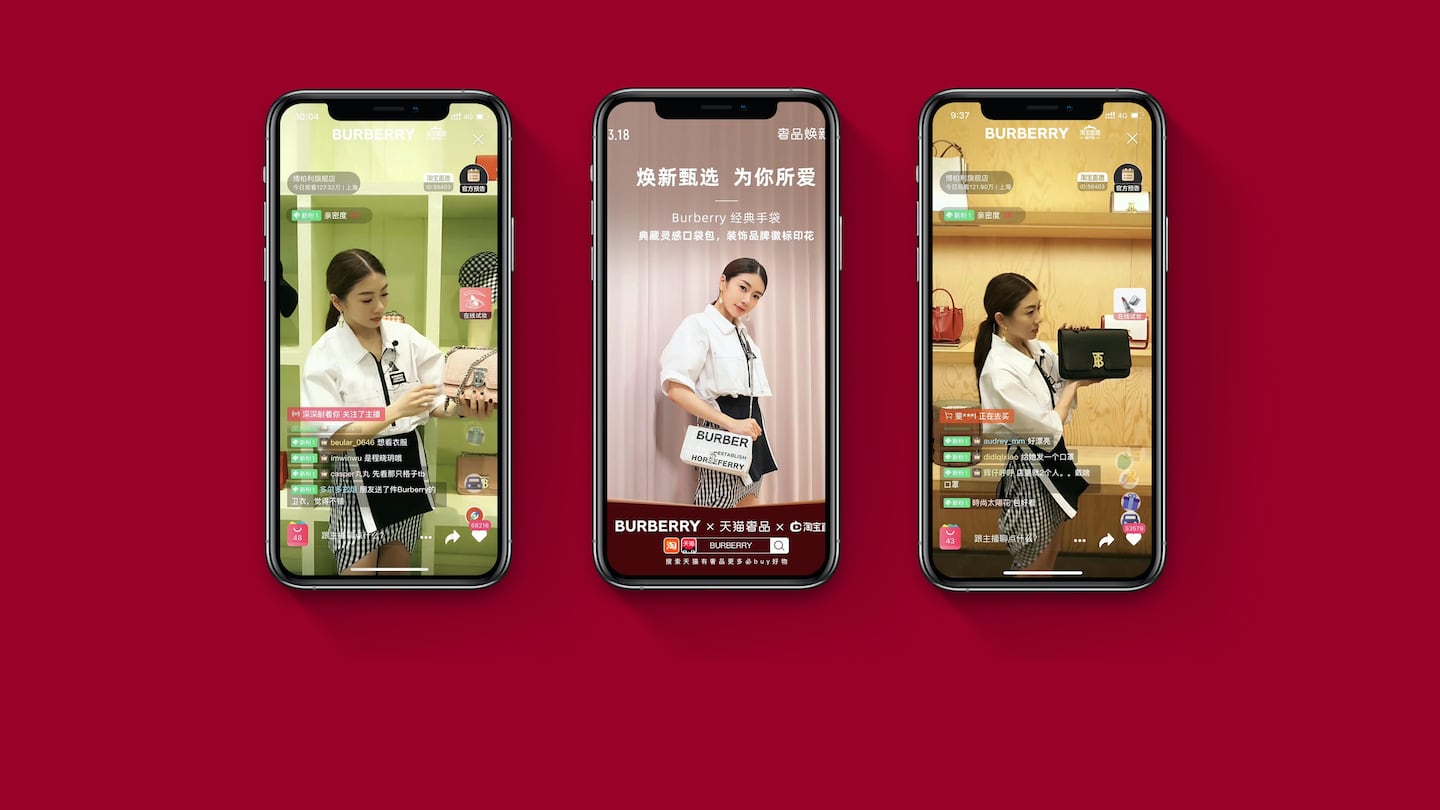
SHANGHAI, China — An impeccably groomed Chinese woman in a crisp white shirt weaves her way around Burberry's flagship store in downtown Shanghai, swinging handbags over her shoulder to try them on for size and asking questions of the attentive sales assistant by her side.
“How much is it? Can you tell me more about the materials?” she asks.
What sets this retail scene apart from countless others is the fact that the shopper was a high-profile influencer (KOL, or key opinion leader, as they are known locally) with more than 6 million Weibo followers, and that her Burberry outing was livestreamed on Tmall, where 1.4 million people tuned in to watch it. Within one hour, many of the Spring/Summer 2020 accessories featured on the broadcast had sold out.
This style of livestream — which took place in March — has become a more familiar sight for Chinese consumers, as a sluggish return of footfall to retail means luxury flagships have doubled up as lush livestreaming sets and sales assistants try their hand at hosting educational sessions focused on new products and styling.
ADVERTISEMENT
Yet the decision to sell in-season ready-to-wear and accessories via livestreaming on Tmall was still seen as a brave one for a luxury player like Burberry. Other brands have since followed its lead by experimenting with the medium for greater reach and improved sales.
“Customers are craving newness, and livestreaming is a safe and exciting way for us to deliver exactly that, especially at a time where some customers are not able to join us in stores,” Josie Zhang, president of Burberry China, explained in her introduction to Burberry’s Tmall livestream session.
When Louis Vuitton became the first luxury brand to experiment with the brand-new livestreaming capability on social-commerce platform Xiaohongshu in late March, they tapped the same influencer, Yvonne Ching, for a starring role. On that occasion, her role was more of a traditional host, taking viewers through each part of her own head-to-toe Louis Vuitton ensemble, and interviewing guest celebrity Zhong Chuxi in front of a virtual audience of 152,000.
The reaction was mixed, with some viewers praising the natural, chummy atmosphere of the livestream as being wholly appropriate for Xiaohongshu, which has been built on its strong community of mostly young urban women offering one another advice and reviews on branded products. Others, however, criticised the session because they felt that the bare bones set was mismatched with Louis Vuitton's brand positioning.
“That could have been executed a lot better than it was,” says Lauren Hallanan, the head of marketing at WeChat management firm Chatly, of Louis Vuitton’s livestreaming debut. “My Chinese assistant said she felt as though she was watching a cheap Taobao shop. It just didn’t feel like the brand.”
Brands are really trying to figure out how to have it both ways, but that's impossible.
Part of the problem with the aesthetic of Louis Vuitton’s livestream seems to be teething issues on the part of its chosen platform, with Xiaohongshu lacking some of the technical innovations and back-end support for livestreaming that Tmall has developed over the years.
Yvonne Ching is sanguine about the criticism, pointing out that any big brand experimenting with new digital platforms and tools in China is going to generate a “lot of talk, including negative voices.” However, Ching noted that every luxury brand is looking to find a way to leverage Chinese "live commerce" right now and brands that do well will be those who design the experience for the audience on specific platforms.
“If you are using [a platform like] Douyin or Xiaohongshu and you care too much about the brand image and your voice is very authoritative and official, people won’t feel as close to you,” Ching explains.
ADVERTISEMENT
“Brands are really trying to figure out how to have it both ways, but that’s impossible. With the virus, a lot of brands are choosing to take a risk and try new things. If you don’t try you’ll never know,” she adds.
These days, almost every luxury brand active in China is considering some kind of livestreaming strategy, balancing the technology’s undisputed power in reaching out to people at a time when outreach has never been more important. The undeniable drawback is that the nature of livestreaming in its current form often looks authentic and accessible, but also cheap.
Not Just a Passing Fad
Livestreaming is not new in China, and has been a major trend in the Chinese e-commerce space since Alibaba first launched Taobao Live in 2016.
By 2019, livestreaming sales in China had reached around $61 billion according to mobile internet research firm iiMedia, a figure predicted to rise to $129 billion in 2020. The technology has both positives and negatives for brands, not only impacting the way fashion is bought, sold and marketed, but also accelerating due to the Covid-19 outbreak.
In February, the movement of China’s massive population was limited by local restrictions to control the spread of coronavirus domestically. At the height of the crisis there, it was estimated that more than 750 million people were living under some level of quarantine, which prompted consumers stuck at home to tune into livestreams as a form of distraction and entertainment.
In that same month, livestreaming platforms saw unprecedented spikes. The number of sellers on the Taobao Live platform increased by 719 percent; on Douyin, a relative newcomer to livestreaming, users spent an average of 120 minutes watching livestreams, compared with 89 minutes watching other forms of content on the app; and on Bilibili, users watched 190 minutes of livestreaming compared to 105 minutes of other video content.
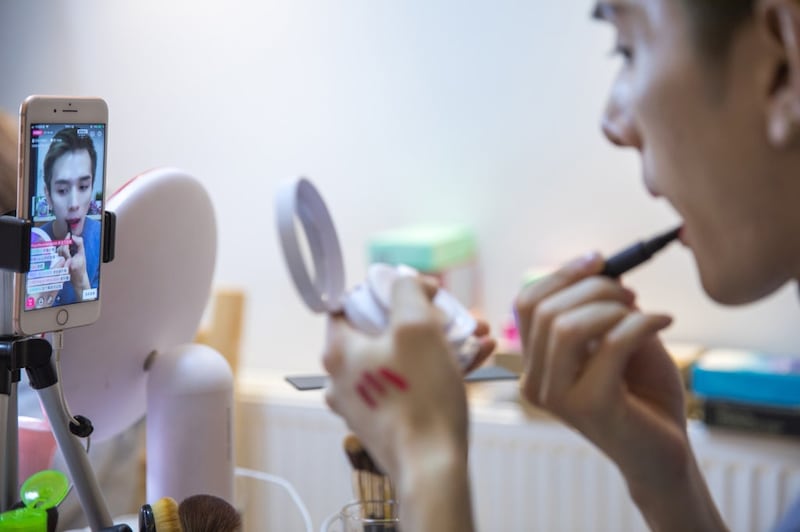
Beauty blogger Austin Li Jiaqi applies lipstick while livestreaming on the e-commerce platform Taobao | Source: Getty Images
ADVERTISEMENT
Traditionally (as much as you can have a “tradition” for a practice that has only really been in use for less than five years) livestreaming has worked in China for brands who want to move mass market products in huge volumes. During last year’s Singles’ Day, daily transaction volume on Taobao Live hit 20 billion yuan ($2.82 billion). More than ten livestreamers each broke the 100 million yuan ($14.1 million) sales mark last year and a further 100 livestreamers achieved sales of 10 million yuan ($1.4 million) on the platform.
Taobao Live’s biggest e-commerce categories are clothing, followed by beauty, parenting, food, and jewellery. Sales on the platform are driven heavily by its top-tier KOLs, with a pricing sweet spot of between 200 to 500 yuan ($28 to $70) for merchandise.
The undisputed royalty of the Chinese livestreaming commerce scene are “Lipstick King” Li Jiaqi, who has 25 million followers on Taobao Live and famously sold 15,000 lipsticks in five minutes. Another livestream native is “Supermarket Celebrity” Viya, so named because of the incredible breadth of brands and product categories she works with. Last month, she even sold out of real rockets that she promoted to her 19 million fans in a quick-fire, high-energy stream of verbal gymnastics.
All this is impressive, but it doesn’t necessarily sound like a good fit for the luxury fashion or jewellery industries. Louis Vuitton obviously disagrees, this week the luxury giant announced it had tapped Li Jiaqi as co-star, alongside actress Song Jia, of its "Chinese Valentine's Day" campaign (the sales event falls annually on May 20, the numbers 520 when read aloud in Mandarin sound similar to "I love you").
In general though, luxury not only sells at a much higher price point than the 200 to 500 yuan sweet spot for livestreaming sales, but it has also built its very existence on the idea of exclusivity. Livestreaming, on the other hand, is generally utilised in China similarly to the way in which home shopping networks in the West, like QVC, encourage viewers to make impulse buys from their sofas.
Luxury Brands on Board
Prior to this year, luxury brands would livestream catwalk shows from the world’s leading fashion weeks to audiences in China, using platforms such as Weibo’s Yizhibo, but before the coronavirus outbreak, none had utilised livestreaming in the way KOLs and mass market brands have done in China, taking advantage of the technology’s most important asset: interactivity.
“Livestreaming is the fastest and most reactive method among all online communications,” says Sara Dong, an Account Manager at Shanghai-based digital marketing agency, Red Ant. “Other content types, posts and websites, you don't get that same level of immediate feedback,” she added.
Yvonne Ching agrees, and believes livestreaming can give luxury brands an advantage in seeing an immediate market reaction to products, which helps them better tailor in store merchandising and PR efforts.
“Brands are getting feedback from their end, and feedback from me; I can pass on the feedback from my fans [also] so, we are all growing together with this input,” she says.
Livestreaming is a risk for brands and influencers; some will gain followers, some will lose followers.
It’s not only brands who are struggling with the best way to tap into livestreaming. Many traditional luxury fashion KOLs in the China market are finding the pivot to livestreaming a challenge, with a totally different skill set required from their background of Weibo posts, WeChat articles or short videos, and the associated time for editing, retouching and generally perfecting needed for their usual content.
Yuwei “Yuyu” Zhangzou, who works with brands such as Dior and Louis Vuitton and recently hosted a livestreaming session for Maje on Tmall that featured more than 100 products, says the difference between her normal content and livestreaming is about more than just form.
“Livestreaming is a risk for brands and [influencers]; some will gain followers, some will lose followers. Your personality becomes more important, some people might like you more, some people will think you’re an idiot,” Zhangzou says, though she, along with many of the brands she and other luxury KOLs work with, are resigned to the fact that livestreaming is an unavoidable part of doing business in China’s increasingly digital luxury landscape.
Livestream, But Make It Luxurious
Another platform that has thrown its weight behind luxury livestreaming is luxury e-commerce site Secoo. Chief Executive Li Rixue says they were working with brand partners to do more in the livestreaming space even before China's coronavirus outbreak. Since then, their efforts have accelerated, he says, with more brands now willing to participate. Even though Li sees great potential in this technology for luxury brands, he acknowledges there are currently limitations.
“Livestreaming for the luxury goods industry needs to make breakthroughs in people, merchandise, and market environment to ensure traffic, quality, and conversion,” Li explains.
“We need knowledgeable and fashionable hosts to precisely target the right audience [as well as] the right merchandising to generate sales now. Thirdly, the right brand environment needs to be provided, building exclusive livestream rooms, which mirror the offline flagship store environment.”

KOLs promoting L'Oréal products via livestream ahead of Singles' Day | Source: Alizila
His cautionary words may not inspire confidence in the medium, in a year when the luxury industry will see sales drop by as much as 35 percent, according to a report released by Bain and Co. last week. But meeting Chinese consumers on the platforms and in the ways they want seems sensible, if not necessary.
Li points out that China’s Post-'80s and '90s generations account for 30 percent of China's e-commerce market and “an engaging livestream will bring the most intuitive online experience to this target group of consumers.”
Perhaps the best course for luxury brands is to think of livestreaming less as a primary sales channel, and more as a powerful customer relations tools that utilises interactivity in a way that converts followers to customers and helps keep them loyal.
Lauren Hallanan suggests a shift away from thinking of livestreaming as necessarily being a “one-to-many” proposition — as it is on Xiaohongshu, and especially on Taobao Live — to a tool with more intimate usage, but greater impact. She imagines a scenario in which luxury brands with a WeChat mini-program take advantage of WeChat’s new livestreaming tool, currently in beta-testing with a few brands, to invite VIPs to exclusively view new or limited-edition products.
Dior is one luxury brand that has done just this, last month running two separate livestreams for VIPs through its WeChat mini-program. One introduced the womenswear summer collection and the other focussed on male VIPs, pre-launching the brand’s collaboration with Stussy. “It’s in a similar vein to offline experiences but bringing it online. I’m sure that kind of event would generate some sales; also having those kinds of exclusivity incentives can encourage purchasing, as opposed to the price incentives offered in mass-market livestreaming,” Hallanan says.
“That could be a huge opportunity for luxury brands as opposed to these mass audience, brand awareness type [activations.]”
时尚与美容
FASHION & BEAUTY
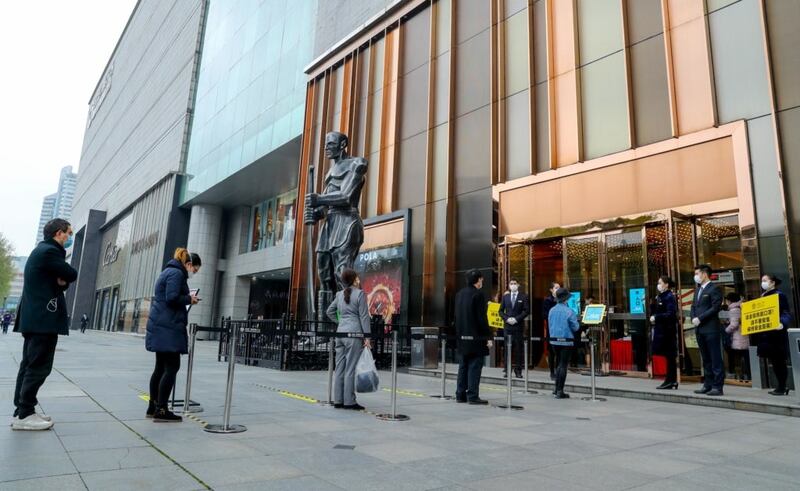
Customers wearing face masks line up to enter Wushang Plaza Shopping Centre in Wuhan, Hubei Province of China | Source: Getty Images
Chinese Customers Rush to Beat Luxury Price Rises
As rumours circulated on Chinese social media that a range of luxury brands, including Chanel, Dior and Gucci would soon increase their prices (as Louis Vuitton already did on May 5), customers formed lines outside of stores in Shanghai, Guangzhou and Beijing in order to buy before the hikes. The strongest luxury brands, including Louis Vuitton and Gucci, have seen a strong continued performance in China, as wealthy consumers to-date remain un-phased by short-term economic pressures. Questions remain as to how many price hikes they will be prepared to weather as the country's patchy recovery continues. (Jing Daily)
A Bubble Tea Brand is Making Global Beauty Brands Popular
Fenty Beauty is the latest beauty brand to collaborate with Heytea, a Tencent-backed bubble tea brand valued at $2.3 billion, releasing a limited-edition make-up bag with a coupon inside for a peach-flavoured Heytea drink to promote Fenty Beauty's new Cheeks Out cream blush collection. Fenty is just the latest beauty brand to partner with Heytea – Clarins, L'Oréal and Clinique, as well as Chinese-native beauty brands Pechoin and Marie Dalgar have already tapped the buzzy bubble tea company that is wildly popular with young Chinese women, for collaborations. (Glossy)
科技与创新
TECH & INNOVATION
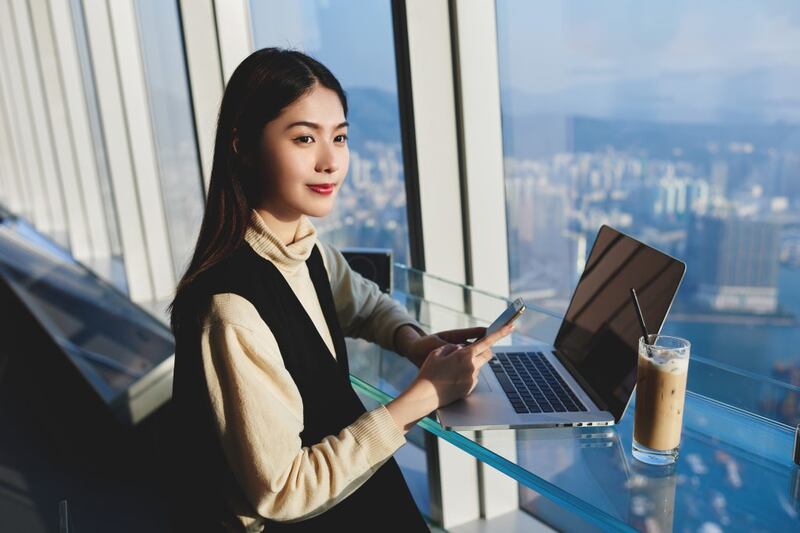
Chinese shopper on her mobile phone | Source: Shutterstock
Tmall Reveals Post-Outbreak Trends
At Tmall's annual TopTalk conference this week, China's leading e-commerce platform unveiled some prevailing trends in the sector in the wake of China's coronavirus outbreak. Tmall data shows an increase of two million merchants since the virus first hit China. Since April, the average daily turnover of brand merchants increased by 40 percent year-on-year. (Sina)
TikTok Makes London its European Hub
Owned by Chinese tech giant ByteDance, TikTok has its biggest overseas office in Los Angeles, but London has quietly emerged as a close second. The company has reportedly been on a recruiting spree in London, luring engineers and tech staff away from other global giants, including Google and Facebook. (CNBC)
消费与零售
CONSUMER & RETAIL
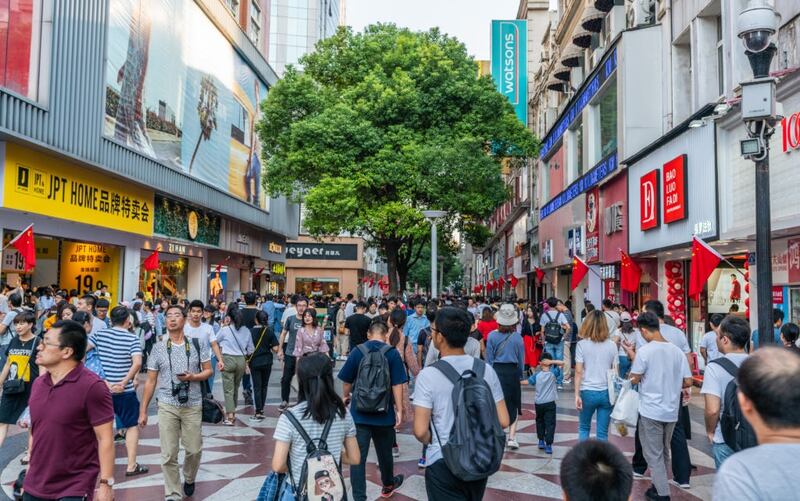
A shopping street in Wuhan, China during Golden Week in 2019 | Source: Shutterstock
Covid-19 Wipes $420 Billion from China Retail Market
A new GlobalData report estimates China will lose 3 billion yuan ($420 billion) in retail sales this year. Before the coronavirus came along, mainland China was on track to achieve 7.7 percent retail growth this year, now GlobalData projects China's retail sales will fall 1.8 percent by year end. (Inside Retail Asia)
Prime Hong Kong Retail Rents Lowest in 12 Years
In Hong Kong's Russell Street — which in recent years has vied for the title of world's most expensive shopping street — rents were down 27 percent from a year earlier in local-currency terms, according to data released by Cushman & Wakefield. The average rent dropped to the equivalent of $2,000 a square foot annually, the lowest since the firm began tracking at the start of 2008, and less than a third of the 2013 peak. For the best locations in the Central and Mong Kok districts, rents are also at their lowest in Cushman's records; for the most desirable part of Tsim Sha Tsui, the lowest since 2009. (Wall Street Journal)
政治,经济与社会
POLITICS, ECONOMY, SOCIETY
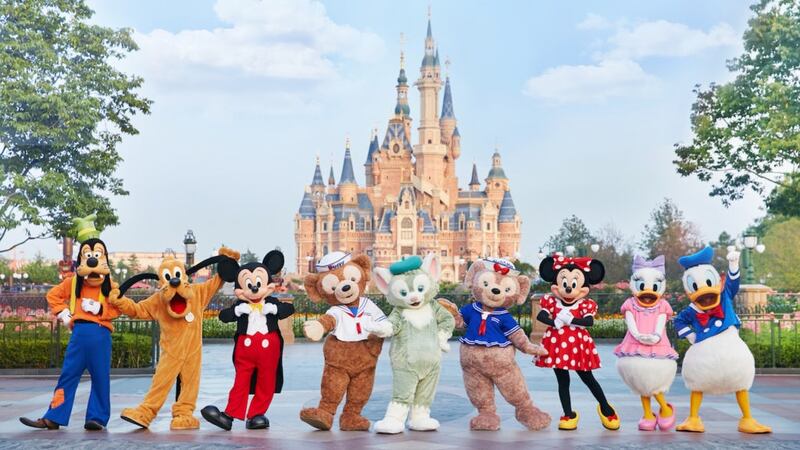
Shanghai Disneyland | Source: Disneygo.com
Shanghai Disney Opens for Business, Post-Pandemic Style
This week's re-opening of the Shanghai Disney Resort may give the world some indication of how large public gatherings will look in the wake of the coronavirus pandemic. The park re-opened on Monday following three months of suspended operations, with ticket sales limited to less than one third of normal capacity, an army of cleaners disinfecting surfaces at regular intervals, social distancing protocols in place, along with mandatory masks and temperature checks for all visitors. (SixthTone)
Wuhan to Test Entire Population as Infections Re-Emerge
Wuhan, the epicentre of the Covid-19 outbreak in China, plans to test its entire 11 million population after new infections appeared more than a month after the city ended a lockdown. District officials in the city said they received orders to submit plans to arrange nucleic acid tests for all residents under their purview within ten days after six new cases were confirmed Sunday and Monday in the same residential compound. The new cases in Wuhan raised concerns of a wider resurgence as businesses restart and people resume normal activities across the country. (Caixin)
China Decoded wants to hear from you. Send tips, suggestions, complaints and compliments to our Shanghai-based Asia Correspondent casey.hall@businessoffashion.com.
With consumers tightening their belts in China, the battle between global fast fashion brands and local high street giants has intensified.
Investors are bracing for a steep slowdown in luxury sales when luxury companies report their first quarter results, reflecting lacklustre Chinese demand.
The French beauty giant’s two latest deals are part of a wider M&A push by global players to capture a larger slice of the China market, targeting buzzy high-end brands that offer products with distinctive Chinese elements.
Post-Covid spend by US tourists in Europe has surged past 2019 levels. Chinese travellers, by contrast, have largely favoured domestic and regional destinations like Hong Kong, Singapore and Japan.